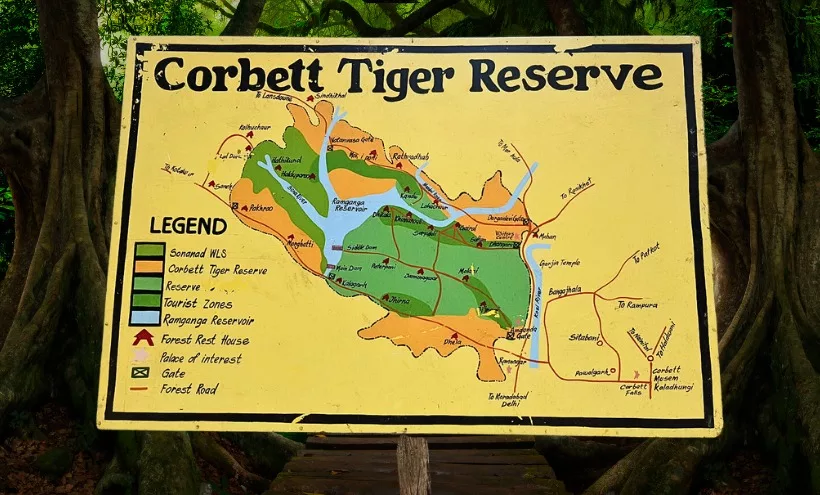
Exploring the Most Popular Corbett Zones and their Specifications in Jim Corbett National Park
In order to effectively manage tourism operations in the tiger reserve area, Corbett National Park is divided into five eco-tourism zones. There are five zones: Dhikala, Bijarani, Jhirna, Dhela, and Durga Devi zones. Two shifts of forest rangers from the Corbett Tiger Reserve oversee the safari trip at each eco-tourism destination.
In each zone, only a few expedition jeeps are allowed. To make sure that tourist traffic is distributed equally across all regions. Each location has its own unique wildlife and natural splendor. Each zone is a component of the same ecological territory. With only a slight topographic difference, the likelihood of seeing tigers is roughly equal in each area.
Explore the comprehensive data provided below for details on each zones unique geographical characteristics and diverse flora and fauna.

Specifications Of Bijrani Zone
Bijrani Zone comprises one of Corbett National Park’s most wildlife-populated ranges, known because of its varied wildlife and amazing vegetation. Bijrani Range is situated near Ramnagar, close to Amdanda Gate. during the Bijrani Safari, visitors have a better chance of seeing a tiger. The Bijrani wildlife zone is recognized for its wildlife, grasslands, and dense, deep woodland with stormy drains.

Bijrani Range, a popular shooting location during the British period, is still popular among wildlife enthusiasts. The Bijrani Range is divided into three sections: core, buffer, and tourist zone. Tourists are only permitted to enter the tourism zone, which begins 5 kilometres after the Amdanda Gate.
- Bird Watching: Because of its diverse variety of avian species, the Bijrani variety is a popular destination for birdwatchers. Among the birds that can be seen in this region are: Crested Serpent Eagle, Pallas’s Fish Eagle, White-crested, Laughingthrush, Rufous-chinned Laughingthrush, Black-headed Jay, Grey Treepie, Indian Peafowl, and lots of others.
- Visit Bijrani Forest Rest House: The rest home is about 9 kilometers inside the forest from Ram Nagar. It also offers a well-kept canteen that has adequate mess facilities, where you can be served a variety of sumptuous dishes organized in a buffet at an affordable cost.
- Nature Interpretation Center: The Bijrani Range can be viewed as an ecosystem in and of itself, with an intricate chain of interdependent interactions between the various species that live there. The forest is host to a wide array of plant species, including sal, khair, ber, and bel, that offer shelter and a meal to a variety of animals.
- Butterfly Watching: The Bijrani Range provides a fantastic chance to butterfly enthusiasts. Visitors can see the vibrant colors and unique patterns of over 50 varieties of butterflies in their natural habitat. A guided tour may enhance the experience and provide insightful information.
- Village Walk: The Bijrani Range provides an idyllic village walk experience where visitors can learn about the rustic lifestyle of the people. The walk takes you through lush green forests, rolling hills, and quaint hamlets, giving you a taste of the local way of life.
Specifications Of Jhirna Zone
Jhirna zone in the southern Corbett National Park is renowned for its easy and best wildlife viewing. Jhirna zone, which is blessed with incredible wildlife beauty, is accessible to visitors all year. Jhirna was once a village that was moved under Project Tiger to another location and has since become a dense forest.

Tourists may observe nilgai, cheetah, and sambhar in their native habitat during a safari to Jhirna Park. The zone is also home to a healthy community of sloth bears and wild elephants. Also, by staying at Forest Rest House FRH Jhirna, one can see lions, who come here at nighttime.
- Lohachaur Forest: The Lohachaur Forest Rest House & Forest Lodge is situated in the Jim Corbett National Park buffer zone. Lohachaur Forest Lodge is situated within Jim Corbett National Park on the banks of the Mandal River, north of its confluence with the Ramganga River. The Lohachaur Forest Rest House & Lodge is available through the Corbett Tiger Reserve’s Durga Devi entrance.
- Kosi River: This unaltered river flows gracefully across the lush towns and valleys of Ramnagar, Uttarakhand, before approaching the Tarai regions of Uttar Pradesh, where it connects together with the Ramganga River.
- Sitabani Temple: The temple is located in the Jim Corbett National Park’s buffer zone, the Sitabani Wildlife Reserve. From Ramnagar, travelers are able to arrange a jeep safari to the shrine, which is encircled by thick forests and provides a tranquil and serene atmosphere
- Kalagarh Dam: In the Pauri Garhwal region of Uttarakhand, the Ramganga Dam, also known as the Kalagarh Dam, is an earth and rock-fill embankment dam constructed on the Ramganga River about 3 km upstream of Kalagarh.
- Jhirna Dam: The Jhirna zone of India’s Jim Corbett National Park is host to Jhirna Dam. This is a small dam established above the Jhirna stream which serves as a water supply for the nearby wildlife.
Specifications Of Dhela Zone
2014 saw the addition of the Corbett Tiger Reserve’s sixth tourist zone, which spans 1173 hectares. The area is known as the Dhela Safari Zone. It was built from the southern buffer woods of the Corbett. The Dhela Forest holds the distinction of being the only location where seven tigers have been observed in Corbett’s 75-year history. The mixed forest plantations and moist deciduous trees in this forest protect a diversity of wildlife, including the Sambhar Deer, which attracts tigers because it is an easy prey item.
Along the 46 km of jungle paths in Dhela, you can see a wide diversity of animal species. For Jeep Safari, there are early and evening shifts available. Only fifteen gypsies are permitted to enter the region per shift. Dhela is particularly known for bird watching. Dhela remains open throughout the year
- Rich Wildlife: It is the residence of tigers, leopards, rhinos, sloth bears, and numerous deer, bird, and reptile species. Its varied vegetation sustains a flourishing ecosystem that draws both nature lovers and researchers.
- Dhela Safari Zone: The safari brings visitors through the dense jungle in an open jeep, giving them the opportunity to spot tigers, elephants, leopards, as well as birds.
- Garjiya Devi Temple: It is one of the most renowned temples in the region, located 13 kilometers from Ramnagar. It also houses the idols of Baba Bhairon, Lord Shiva, Lord Ganesha, and Goddess Saraswati. Within the sanctuary is a 9th Century black granite statue of Lakshmi Narayan.
- Dhangarhi Museum: The Dhangarhi Museum is close to the Dhangarhi Gate. It has become one of the most popular tourist destinations. Since the arrival of man-eating tigers, this museum remains strong on the grounds. The museum sheds insight into Corbett’s life as well as their journey.
- Binsar Wildlife Sanctuary: It is a shielded region in India’s Jim Corbett National Park. It is renowned because of its varied vegetation and fauna, which include rare bird species and an incredible panorama of the Himalayas.
Specifications Of Dhikala Zone
Dhikala is the best and most beautiful safari zone in Jim Corbett National Park, and the Dhangari pass leads to it. Dhikala safari zone or Dhikala canter safari is a faultless location where visitors can freely relax their hearts, minds, bodies, and spirit to nature.
Dhikala provides tourists with a lush setting plus a spectacular view of the complete wildlife in its natural habitat. Dhikala is a tourist area in Jim Corbett National Park where you may hear the sweet chirping of birds, smell the rich and natural fragrance of the flora, and discuss the heavenly environment.
- Elephant Safari: The Dhikala zone also has elephant safaris, but they are only available to tourists staying at the Dhikala forest lodge. The elephants used for safari are restricted in number, and the service is first-come, first served, so the adage “the early bird gets the worm” applies here. There is no prior booking for the elephant safari, so you must pay for it on the spot at the elephant camp.
- Jeep Safari: Jeep safaris in Corbett within the Dhikala Zone provide an amazing wildlife experience. It gives visitors the opportunity to view tigers, elephants, deer, and various other exotic wildlife in their natural surroundings.
- Overnight Stay in Forest Rest House: If you’re looking for a Dhikala night stay booking, Dhikala Zone provides an exciting overnight stay in a forest rest house surrounded by the grandeur of dense woodland and wildlife. Experience the thrill of hearing sounds from animals at night while relaxing in the comfort of a cozy room.
- Riverside Picnics: Enjoy a riverside picnic in the Dhikala Zone, encircled by lush forests and wildlife, with scenic vistas of the Ramganga River. Ideal for those willing to have a Jim Corbett package or wildlife and adventure enthusiasts.
Specifications Of Durga Devi Zone
Durga Devi Zone is a hill safari zone within Corbett National Park that is rich in wildlife beauty and excitement. Durga Devi Range, located on the park’s northeastern border, is bordered by the Ramganga and Mandal rivers. This area is well-known for its wild elephant sightings, and tourists can also enjoy fishing at Domunda Bridge. The famous Mahasheer fish may additionally be found in the Durga Devi Range’s watercourse water. The green forest in this range also offers an abundance of chances to enjoy bird watching.
- Visit the Durga Devi Temple: Durga Devi gate is the primary entry point into Corbett National Park’s Durga Devi Range. Durga Devi Gate, located 28 kilometers from Ramnagar town near the Ramganaga River, gives access to the hilly region of Corbett Tiger Reserve.
- Visit the Laldhang-Chaur Area: A tranquil grassland region called Laldhang Chaur can be found in Jim Corbett National Park. It has a beautiful view of the Shivalik mountain range and is home to many different animals, including lions, elephants, and deer. a place that wildlife and nature enthusiasts must explore.
- Visit the Kosi River Bridge: A beautiful perspective of the river and neighboring mountains can be found from the Kosi River Bridge in the Durga Devi Zone. Numerous bird species can be noticed on the bridge throughout the day, making it a favorite location for bird watching and photography.
- Visit the Hanuman Temple: Lord Hanuman’s temple in the Durga Devi Zone is a revered site of worship. It is situated in a peaceful area and draws a lot of devotees looking for favors and spiritual comfort. Both followers and tourists should go here.
- Visit the Vatanvasa Gate: Wildlife lovers may experience the park’s varied flora and fauna by entering the Corbett Tiger Reserve through Jim Corbett’s Vatanvasa Gate.
Conclusion
Wildlife enthusiasts and admirers of the environment will both enjoy Jim Corbett, National Park. As we told earlier, the park is split into several zones, each of which has its own specifics and features. The most well-liked areas of Corbett, like Dhikala, Bijrani, and Jhirna provide breathtaking Himalayas views, a wide variety of flora and fauna as well as exhilarating adventure activities.
Jeep excursions, birdwatching, trekking, and other activities are available to visitors.
Exploring the well-known areas of Corbett offers tourists a once-in-a-lifetime opportunity to connect with nature and make lifelong memories. Plan your next trip with Corbett Tiger Reserve. Many people’s imaginations have been captivated by Jim Corbett Tiger Reserve’s diverse wildlife and breathtaking landscapes.


